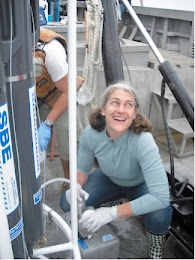What better way to appreciate the longest day of the year than waking up at 05:30AM? So, that’s what we did on this year’s summer solstice on June 20. We awoke to an overcast commute down the I405S freeway (one of the busiest in the country) in Los Angeles, CA to San Pedro, CA, but at these hours, of course, traffic is very light. We arrived in time to load the ship with plenty of time to spare for the 7AM departure. Our ship departed from the LA Harbor which is about 25 miles south of downtown LA and the University of Southern California (USC). The LA Harbor is the busiest port in the US and one of the busiest in the world.. Our destination was the San Pedro Ocean Time-series (SPOT) which is about halfway between the mainland in San Pedro, CA and Santa Catalina Island. SPOT is an on-going 12+ year monthly marine microbial time-series. We examine the dynamics of the microbial communities including protistan, bacterial, archaeal, and viral communities. The results show very interesting annually repeating cycles and co-occurrence patterns which may suggest ecological interactions (similar to those easily observed in larger organisms).
With flat seas, it took about an hour to get out to our sampling location. Once on station, we successfully launched our brand new, hopefully very reliable, Rosette/CTD package (THANKS, NSF!!!) down to just above the bottom at 890 meters. This cruise was different than the typical SPOT cruise because we aimed to filter the special samples for Ocean Sampling Day on-board the ship rather than collect and filter back at the lab like we do for the monthly samples. Once the rosette package returned back on board, we collected 2 4L replicates from the 150m, 500m, 890m depths and 4 1L quadruplicates from the chlorophyll maximum (30.2m) and 5m depths. We used peristaltic pumps (7 channels total) to power through all the samples in about an hour. We pre-filtered the samples through an 80um mesh to remove larger organisms (like copepods). The filters were immediately placed on dry-ice. In addition to the OSD samples, we carried out our monthly sampling that included collection of more microbial DNA, bacterial production, and bacterial and viral enumeration.
Upon return to the LA Harbor, we had a minor glitch when we found out that due to homeland security our port was closed, which obviously left us thinking, “Oh no, how long are we going to stuck out here?” However, the captain had a plan and we steamed over to another nearby dock which took an extra 20 minutes. We planed to take cabs over to the vans to return to campus. However, when we arrived at the new dock, the captain found out that our regular dock was open to boats so we returned and went about our business – never a dull moment!
Extra fun stuff: When we looked at the samples from SYBR green epi-fluorescence microscopy we observed that the virus-to-bacteria ratio and Synechococcus abundance were quite high—about 30 and >150,000/mL, respectively.
Diane Kim, Troy Gunderson, and David Needham (L-R) pose with the brand new, NSF-funded CTD/rosette before its first official SPOT deployment.Credit: Victoria Campbell
View of Santa Catalina Island from the San Pedro Ocean time-series through the morning marine layer from R/V Yellowfin. Credit Diane Kim
4 1L replicates from the 5 m depth at the San Pedro Ocean Time-series on ocean sampling day. Note the lighter color on these Sterivex compared with the 5 m samples. Credit: David Needham
4 1L replicates from the chlorophyll maximum at the San Pedro Ocean Time-series on ocean sampling day. Note the darker color on these compared with the 5 m samples. Credit: David Needham
Epifluorescent microscopy images from the 5m depth at the San Pedro Ocean Time-series. Both images were from the same field on a 0.02µm Anodisc filter stained filter stained with SYBR green I. The upper image shows the bacteria and viruses with concentrations greater than 1 and 10 million per mL, respectively. The lower filter shows orange auto-fluorescence of Synechococcus from the same field of view. Credit: David Needham
Cathy Roney happily prepares to collect a sample for Ocean Sampling Day Credit: Diane Kim
Victoria Campbell happily attaches tubing to the Niskin to gently sample the protistan community within. Credit: Diane Kim
Victoria Campbell, Troy Gunderson, and Michael Morando (L-R) sample from the new SPOT CTD/Rosette on Ocean Sampling day Credit:Diane Kim
Jenni Cardell happily takes instruction on how to fill a cubitainers on her first SPOT cruise. Credit Diane Kim
Brian Seegers and Victor Hernando-Morales (L-R) happily sample from Niskin bottles on ocean sampling day and the San Pedro Ocean time-series.
Credit: Diane Kim
David Needham (Fuhrman Lab- USC)
USC Ocean Sampling Day Participants:
Victoria Campbell, Jenni Cardel, Jacob Cram, Troy Gunderson, Victor Hernando-Morales, Diane Kim, Michael Morando, David Needham, Cathy Roney, Brian Seegers













